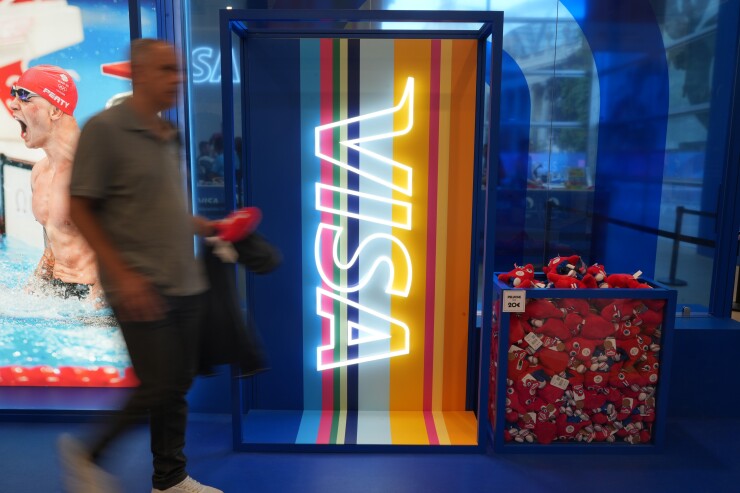
In an attempt to reach the large and rapidly growing Asia-Pacific e-commerce market, Visa is turning to digital payment technology that's designed to replicate the interoperability of in-store and contactless payments.
Visa has entered strategic partnerships with payment processors including Adyen, Worldpay, AsiaPay and Singapore-based fintech 2C2P to boost the card brand's Click to Pay product in Asia. These collaborations follow an earlier deal between Visa and ZA Bank in Hong Kong to introduce Click to Pay in ZA Bank's footprint.
Visa, which in recent months has made a series of
"This looks like a coordinated effort to increase the use of cards in a region that is today mostly using domestic wallets centered around mobile phones or direct bank transfers," Aaron McPherson, principal at AFM Consulting, told American Banker. "As such, Visa and its partners have an uphill battle. While the benefits they cite are valid, those are equally applicable to existing digital payment methods."
Big market
Even if it's a challenge, the market is huge and getting larger. The Asia-Pacific e-commerce market is on pace to pass $4.4 trillion in 2025, according to
"Growth is underpinned by mobile-first retail habits, rapid 5G roll-outs, and government programmes that bring millions of first-time shoppers online," Mordor said in its report on Asia-Pacific e-commerce. "Competition consequently shifts toward ecosystem leadership, with super-apps leveraging payments, entertainment, and finance to deepen user lock-in."
Visa is leaning on authentication and easy payment execution to expand in the region. Visa's Click to Pay enables consumers to use substitute details to execute payments via an email or mobile phone number, removing the need to enter or use payment card details for e-commerce purchases.
Read more about mobile payments.
The process, called tokenization, replaces card numbers with a single-use substitute. This is designed to prevent fraud by making the card unusable if stolen. Tokenization uses a protocol that Visa, Mastercard, Amex, Discover and other card companies have agreed to, making online payment processing agnostic to card brands, similar to in-store credit cards. (The term tokenization in this case is being used differently than the process of turning real-word assets into tokens on a blockchain in cryptocurrency.)
The card brands'
Local expertise
The processors in the deployment have a presence in Asia-Pacific region, which aids in managing local regulatory and payment system differences among countries in the area. Visa additionally called out Adyen's biometric authentication system. Adyen uses multifactor authentication, enabling users to set up an SMS, email or biometric log-in. Adyen did not return a request for comment and Visa did not comment. "For online merchants that do business across the region, this may be an attractive way of simplifying their checkout screens, but consumer behavior is sticky, and merchants are more willing to integrate local methods than they are to try and change consumer behavior," McPherson said.
In the Asia-Pacific region, the adoption of contactless payments is surging, with consumers preferring to tap and pay due to speed, convenience, and security over other payment methods, Visa said in a document on its Asia-Pacific expansion, which uses both contactless and e-commerce mobile payments.
"While contactless payments in-store are rapidly growing, Click to Pay can help streamline and simplify customers' online journeys," Visa said.
Visa positions Click to Pay as similar to contactless payments but designed for e-commerce, saying it is browser and device agnostic.
"Contactless has been the key to physical cards staying relevant in a mobile-first world," Tony DeSanctis, a senior advisor at Cornerstone Advisors, told American Banker. While mobile and contactless point of sale payments are two different channels, both can be a part of expanding, according to DeSanctis. "Contactless is perhaps the only thing that's easier than using a mobile device to make a payment at the point of sale," DeSanctis said. "As more transactions move online, this will become less relevant, but that is likely still a decade or so away."





